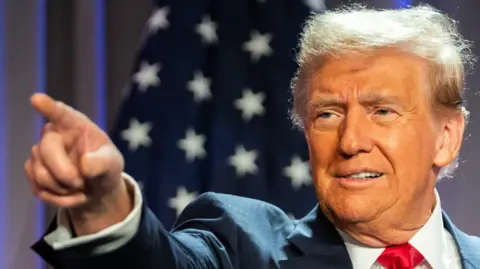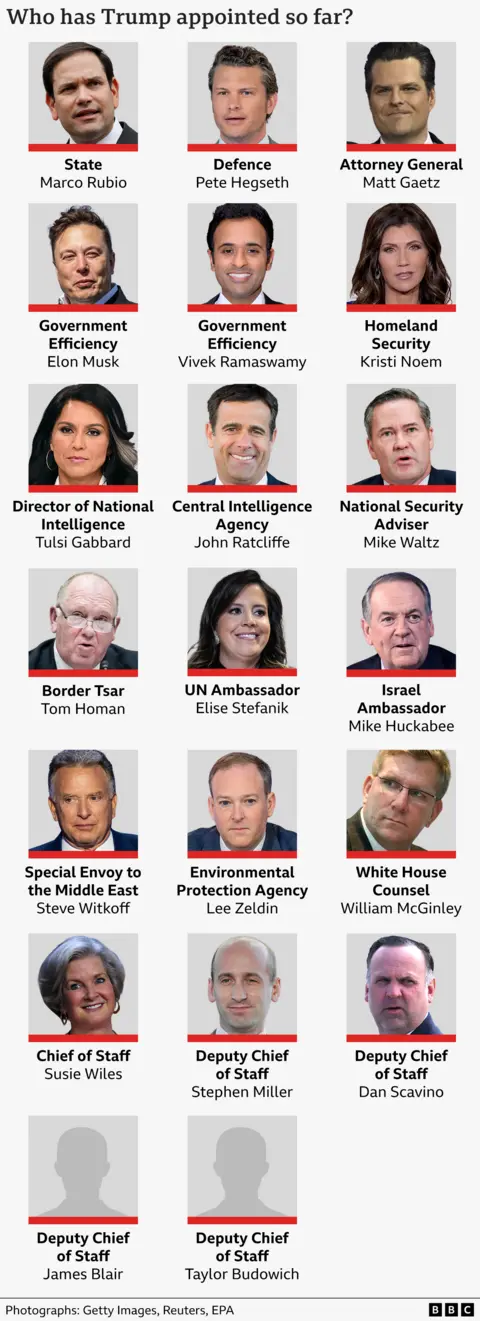 Shutterstock
ShutterstockDonald Trump has been announcing key hires for when he becomes US president in January.
But some of those personnel decisions will not be automatic.
Even with the backing of the future president, many of those chosen for a top job in Trump’s cabinet or administration must go through further vetting.
Several of the posts require a Senate hearing and a majority of the chamber’s approval.
But there is a clause in the Constitution that allows a president to unilaterally appoint a nominee if the Senate is on recess, or not in session.
Senate vetting: How does it work?
More than 1,000 positions – including the 15 officials chosen to lead executive departments, known as the Cabinet – typically require Senate approval. This also includes ambassadors and even some lower-level positions.
But many members of Trump’s team, including those who work in the White House or posts like the national security adviser, don’t require Senate approval. They still are vetted, however, by the administration and could face intensive FBI background checks.
The Senate approval process requires nominees to submit financial disclosure forms, fill out a questionnaire – which differs based on the role – and testify before a Senate committee.
These hearings can sometimes be contentious. They allow members from both political parties to question nominees about their backgrounds and plans for the post.
After the hearing, the committee votes on the nomination. If it approves the candidate, the full Senate then votes on the nominee.
Historically, the upper chamber has approved cabinet positions quickly – sometimes with little or no debate. But “political and partisan conflicts between the president and senators have at times produced dramatic fights over cabinet nominees and led to their ultimate withdrawal or rejection”, the Senate’s historical website notes.
Bitter political brawls over Trump’s picks could be limited somewhat because Republicans will control both chambers of Congress when the president-elect takes office in January.
But some Republicans already have questioned at least one Trump choice, Florida congressman Matt Gaetz, the nominee for post of attorney general, or top prosecutor in the US.
What are recess appointments?
The vetting and approval process for nominees can be lengthy, but it was included in the US Constitution to provide a check on presidential power. It is also designed to rule out corrupt or unqualified nominees.
There is, however, an exception to this process – recess appointments – which Trump appears intent to use to ensure his appointments are able to take office.
Basically, the process says that when Congress is in recess – meaning it’s not in session for a duration of time – the president can make appointments temporarily without congressional approval or vetting.
The process was created when Congress didn’t meet as often as it does today, and was to be used in emergencies so presidents would be able to fill positions without delay.
It is also supposed to be a temporary appointment and expires at the end of a congressional session – so at most, one year.
Trump recently said the Senate “must agree” to recess appointments, otherwise “we will not be able to get people confirmed in a timely manner”. He noted that in his past administration, some of his nominees took multiple years to be confirmed.
Trump’s plan to use recess appointments, along with the announcement that Republican senators’ support bypassing the Senate vetting process, is not without precedent.
Some past presidents have employed the method liberally, often as a way of circumventing political divides that would slow nominations.
George W Bush made 171 recess appointments, Bill Clinton made 139 and Barack Obama made at least 32, according to the Congressional Research Service (CRS).
This method of getting nominees into office was virtually stopped after the Supreme Court ruled against Obama in 2014, striking down multiple recess appointments and calling them unconstitutional.
Josh Chafetz, a constitutional law professor at Georgetown University, says recess appointments are “not meant to be a mechanism for circumventing Senate consent”.
While other presidents have used them, Prof Chafetz says: “I can’t think of an instance in which the Senate majority has triggered a recess simply so that a president could make recess appointments.”
When can Trump make recess appointments?
According to Prof Chafetz, there are two paths Trump could take to making recess appointments.
The first would involve the Senate agreeing to recess for 10 days or more by majority vote.
The second would involve the House voting for a longer recess than the Senate, which would allow Trump to invoke a never-used constitutional power to adjourn both chambers of Congress.
According to the US Constitution, “in Case of Disagreement” a president can adjourn both chambers of Congress until “such Time as he shall think proper” – which would then provide Trump an opportunity to make recess appointments.
Trump previously threatened to use this power when he was in the White House.
In 2020, during a pandemic briefing, Trump said that he would “exercise my constitutional authority to adjourn both chambers of Congress” to make recess appointments if his nominees before Congress were not approved.
Prof Chafetz stressed that this route has never been used before in US history, and so “no-one is quite sure how it would work”.
He added that Trump cannot make any recess appointments until he is president. His inauguration is scheduled for 20 January.










